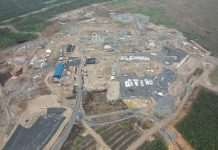WINNIPEG – COLUMN – In early March, the Manitoba Geological Survey and its industry partner, Lynx Consortium, made an important diamond discovery southeast of Thompson. While there is no guarantee the find will lead to a significant mining project, the province should move quickly to enhance the potential by involving industry partners, First Nations and municipalities in the region.
If this development works out, Manitoba would join Ontario, Quebec and the Northwest Territories in profiting from diamond mining. Royalties, employment opportunities and tax revenue may lie ahead from, and in, places where they are sorely needed. Mining is a long-term venture relying on good economic policies, political stability and the prospect of decent returns on investment. The provincial government should be careful, but also reasonably venturesome.
To move forward, the province will have to involve northern First Nations. Indigenous communities would best become true partners in the venture to avoid problems that have plagued some other ventures and communities, such as Attawapiskat First Nation in northern Ontario. The chief of that isolated community decided that the draft agreement being considered with diamond producer De Beers was inadequate and let the project and the work opportunities go — a lost opportunity.
In 2012, then Grand Chief David Harper of the MKO (Manitoba Keewatinowi Okimakanak) — the organization representing 30 northern Manitoba First Nations — complained that the province was holding up northern mining development by excluding First Nations from discussions and decisions. His criticisms were corroborated by mining executives.
The Fraser Institute’s annual Survey of Mining Companies reports and rates mining policy environments around the world. To no surprise, northern Manitoba was then ranked 20th. The main problem: mishandling of First Nation consultations, leading to excessive delays in granting permits. In response, the former NDP government dramatically improved pre-development conditions. Today, Manitoba is ranked second worldwide. Improvements were particularly focused on reducing the degree of uncertainty in regulations and taxation.
Manitoba’s new Progressive Conservative government must continue with these positive policies.
In 2016, the NDP government increased the incentives for mining exploration, boosting the Mineral Exploration Assistance Program (MEAP) to 50 per cent from 40 per cent. This program provides financial assistance for non-fuel mineral exploration in Manitoba, sharing eligible expenditures based on the location of the proposed project.
As well, the level of mining investment tax credits was increased while the government committed to building northern roads to serve development. Also of critical importance: the province improved its consultation with indigenous communities with regard to mineral exploration and development.
The province’s Mining Advisory Council is now bearing fruit. The advisory council was the first of its kind in Canada, having representatives from First Nations, mining companies and the provincial government. The body has prioritized exploring revenue-sharing formulas, and benefit agreements, with an eye toward ensuring there is a duty to accommodate aboriginal rights. In addition, the council is working on improving First Nations procurement and business co-ventures. The council prefers that First Nations are full equity partners in northern mining projects.
Manitoba could be a world leader in promoting and supporting mining. While other provinces and territories regularly make the news when it comes to mining, mining is actually Manitoba’s second-largest resource sector. Back in 2013, when the council was created, 40 companies were active in mineral exploration and the industry employed close to 1,000 indigenous workers. A new diamond mining development could create many more new jobs. It could also drive the development of northern infrastructure, including roads and access to potable water.
Mining operations are expected to contribute about $1.5 billion to the provincial economy this year, which would represent about 2.7 per cent of the province’s gross domestic product. Approximately 3,200 workers are employed in Manitoba’s mining industry.
The province should strongly pursue the new “diamond” opportunity. Both our provincial government and First Nations, through their band councils, need to co-operate, working at landing the opportunity at the expected “speed of business.”
Joseph Quesnel is a research associate with the Frontier Centre for Public Policy.







